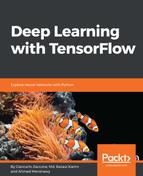Here is the source code for the example explained previously:
import matplotlib.pyplot as plt
import numpy as np
import math
import tensorflow as tf
import tensorflow.examples.tutorials.mnist.input_data as input_data
#LOAD PACKAGES
mnist = input_data.read_data_sets("data/", one_hot=True)
trainimgs = mnist.train.images
trainlabels = mnist.train.labels
testimgs = mnist.test.images
testlabels = mnist.test.labels
ntrain = trainimgs.shape[0]
ntest = testimgs.shape[0]
dim = trainimgs.shape[1]
nout = trainlabels.shape[1]
print ("Packages loaded")
#WEIGHT AND BIASES
n1 = 16
n2 = 32
n3 = 64
ksize = 5
weights = {
'ce1': tf.Variable(tf.random_normal
([ksize, ksize, 1, n1],stddev=0.1)),
'ce2': tf.Variable(tf.random_normal
([ksize, ksize, n1, n2],stddev=0.1)),
'ce3': tf.Variable(tf.random_normal
([ksize, ksize, n2, n3],stddev=0.1)),
'cd3': tf.Variable(tf.random_normal
([ksize, ksize, n2, n3],stddev=0.1)),
'cd2': tf.Variable(tf.random_normal
([ksize, ksize, n1, n2],stddev=0.1)),
'cd1': tf.Variable(tf.random_normal
([ksize, ksize, 1, n1],stddev=0.1))
}
biases = {
'be1': tf.Variable
(tf.random_normal([n1], stddev=0.1)),
'be2': tf.Variable
(tf.random_normal([n2], stddev=0.1)),
'be3': tf.Variable
(tf.random_normal([n3], stddev=0.1)),
'bd3': tf.Variable
(tf.random_normal([n2], stddev=0.1)),
'bd2': tf.Variable
(tf.random_normal([n1], stddev=0.1)),
'bd1': tf.Variable
(tf.random_normal([1], stddev=0.1))
}
def cae(_X, _W, _b, _keepprob):
_input_r = tf.reshape(_X, shape=[-1, 28, 28, 1])
# Encoder
_ce1 = tf.nn.sigmoid
(tf.add(tf.nn.conv2d
(_input_r, _W['ce1'],
strides=[1, 2, 2, 1],
padding='SAME'),
_b['be1']))
_ce1 = tf.nn.dropout(_ce1, _keepprob)
_ce2 = tf.nn.sigmoid
(tf.add(tf.nn.conv2d
(_ce1, _W['ce2'],
strides=[1, 2, 2, 1],
padding='SAME'),
_b['be2']))
_ce2 = tf.nn.dropout(_ce2, _keepprob)
_ce3 = tf.nn.sigmoid
(tf.add(tf.nn.conv2d
(_ce2, _W['ce3'],
strides=[1, 2, 2, 1],
padding='SAME'),
_b['be3']))
_ce3 = tf.nn.dropout(_ce3, _keepprob)
# Decoder
_cd3 = tf.nn.sigmoid
(tf.add(tf.nn.conv2d_transpose
(_ce3, _W['cd3'],
tf.pack([tf.shape(_X)[0], 7, 7, n2]),
strides=[1, 2, 2, 1],
padding='SAME'),
_b['bd3']))
_cd3 = tf.nn.dropout(_cd3, _keepprob)
_cd2 = tf.nn.sigmoid
(tf.add(tf.nn.conv2d_transpose
(_cd3, _W['cd2'],
tf.pack([tf.shape(_X)[0], 14, 14, n1]),
strides=[1, 2, 2, 1],
padding='SAME'),
_b['bd2']))
_cd2 = tf.nn.dropout(_cd2, _keepprob)
_cd1 = tf.nn.sigmoid
(tf.add(tf.nn.conv2d_transpose
(_cd2, _W['cd1'] ,
tf.pack([tf.shape(_X)[0], 28, 28, 1]),
strides=[1, 2, 2, 1],
padding='SAME'),
_b['bd1']))
_cd1 = tf.nn.dropout(_cd1, _keepprob)
_out = _cd1
return _out
print ("Network ready")
x = tf.placeholder(tf.float32, [None, dim])
y = tf.placeholder(tf.float32, [None, dim])
keepprob = tf.placeholder(tf.float32)
pred = cae(x, weights, biases, keepprob)#['out']
cost = tf.reduce_sum
(tf.square(cae(x, weights, biases, keepprob)
- tf.reshape(y, shape=[-1, 28, 28, 1])))
learning_rate = 0.001
optm = tf.train.AdamOptimizer(learning_rate).minimize(cost)
init = tf.global_variables_initializer()
print ("Functions ready")
sess = tf.Session()
sess.run(init)
# mean_img = np.mean(mnist.train.images, axis=0)
mean_img = np.zeros((784))
# Fit all training data
batch_size = 128
n_epochs = 5
print("Strart training..")
for epoch_i in range(n_epochs):
for batch_i in range(mnist.train.num_examples // batch_size):
batch_xs, _ = mnist.train.next_batch(batch_size)
trainbatch = np.array([img - mean_img for img in batch_xs])
trainbatch_noisy = trainbatch + 0.3*np.random.randn(
trainbatch.shape[0], 784)
sess.run(optm, feed_dict={x: trainbatch_noisy
, y: trainbatch, keepprob: 0.7})
print ("[%02d/%02d] cost: %.4f" % (epoch_i, n_epochs
, sess.run(cost, feed_dict={x: trainbatch_noisy
, y: trainbatch, keepprob: 1.})))
if (epoch_i % 1) == 0:
n_examples = 5
test_xs, _ = mnist.test.next_batch(n_examples)
test_xs_noisy = test_xs + 0.3*np.random.randn(
test_xs.shape[0], 784)
recon = sess.run(pred, feed_dict={x: test_xs_noisy,
keepprob: 1.})
fig, axs = plt.subplots(2, n_examples, figsize=(15, 4))
for example_i in range(n_examples):
axs[0][example_i].matshow(np.reshape(
test_xs_noisy[example_i, :], (28, 28))
, cmap=plt.get_cmap('gray'))
axs[1][example_i].matshow(np.reshape(
np.reshape(recon[example_i, ...], (784,))
+ mean_img, (28, 28)), cmap=plt.get_cmap('gray'))
plt.show()
